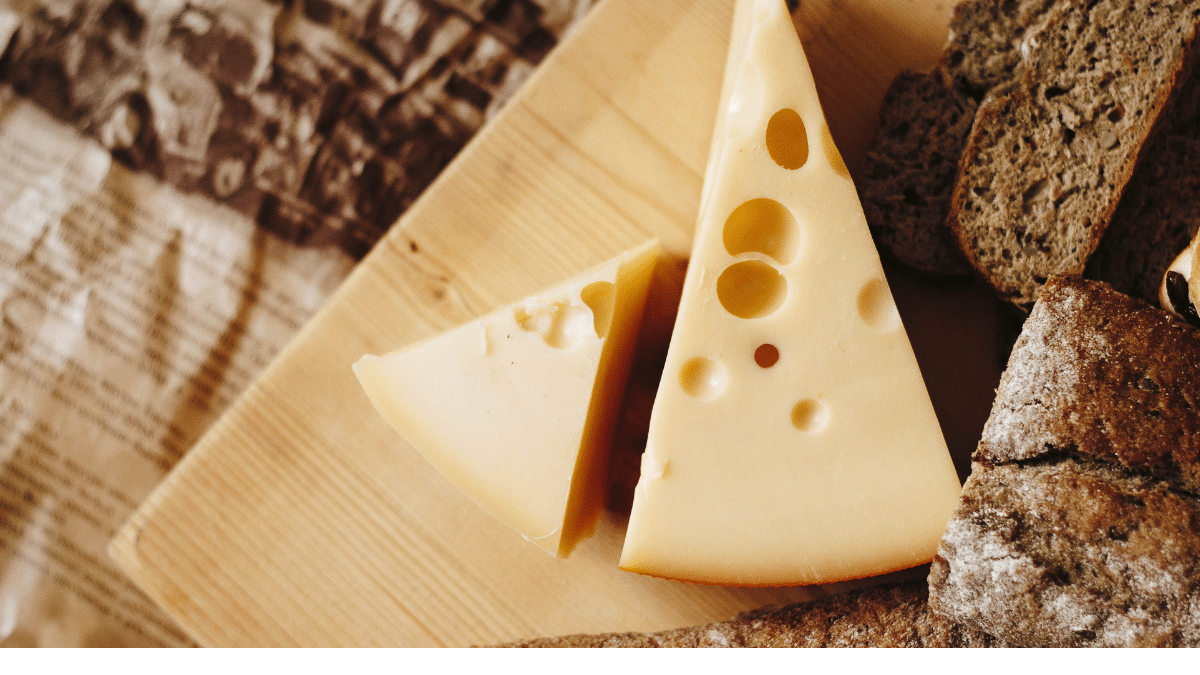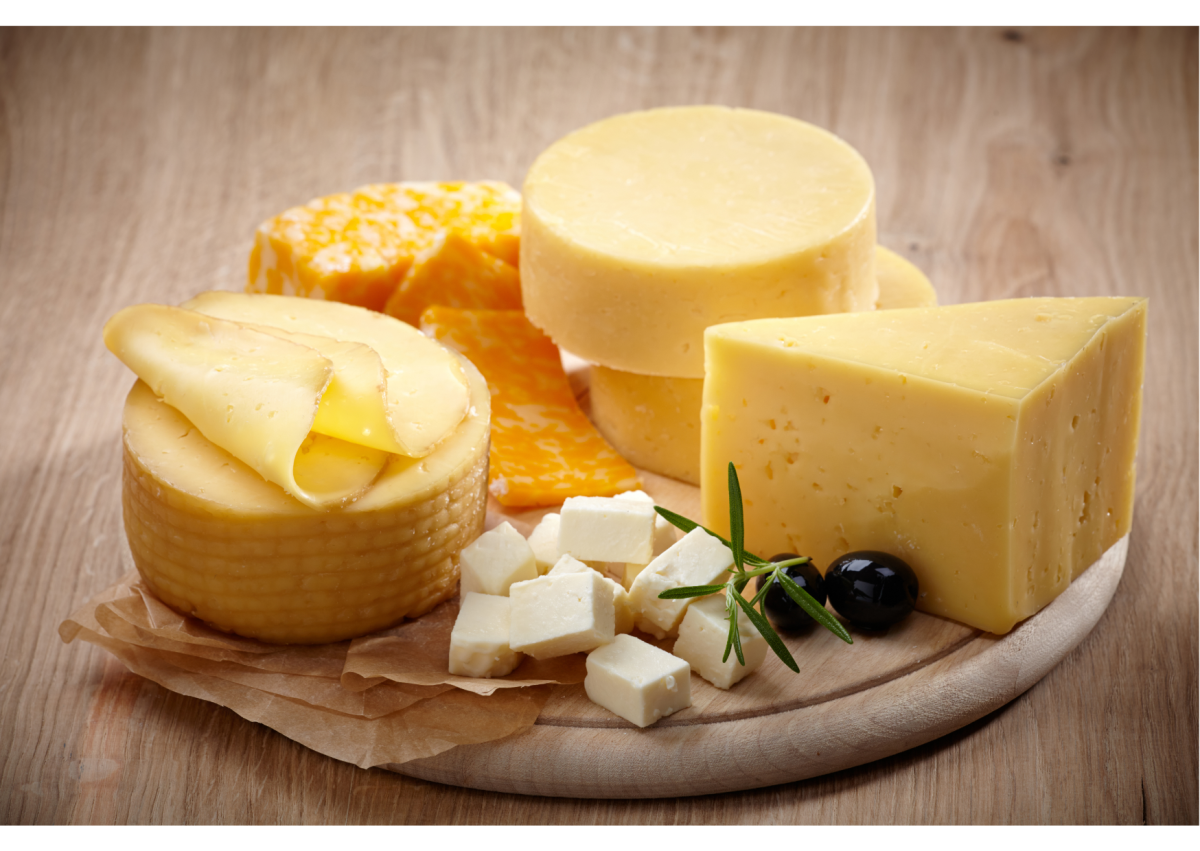Low FODMAP cheese and high FODMAP cheese guide
- Low FODMAP diet
You might be wondering if there is such a thing as low FODMAP cheese? Many people think that they need to avoid cheese altogether on a low FODMAP diet, but this simply isn’t the case.
In this article, we will discuss which cheeses are FODMAP friendly and how cheese can fit into your low FODMAP diet.

How can cheese be low FODMAP?
Not all cheese is created equally when it comes to FODMAP levels. This depends on how the cheese is manufactured and aged.
The FODMAP that we are concerned about with cheese is lactose. Lactose is a naturally occurring sugar known as a disaccharide, which is found in milk and dairy products.
Low FODMAP cheese includes all hard cheeses, as well as some other types. This is because the lactose is destroyed or removed during the cheese-making process.
It is important to note that although lactose is a FODMAP, you don’t need to avoid lactose completely if you do not have a diagnosed lactose intolerance (1).
What kind of cheese is low FODMAP?
Generally speaking, the fresher the cheese – the less it’s been aged, the more lactose it will have.
Therefore, hard and mature cheeses tend to be lower in FODMAPs as most of the lactose has been removed during the cheese manufacturing process (2).
Below is a list of low FODMAP cheese (3):
- Brie cheese
- Blue cheese
- Camembert cheese
- Havarti
- Cheddar cheese
- Parmesan
- Monterey Jack cheese
- Mozzarella
- Comté cheese
- Pecorino Style cheese
- Swiss cheese
Note this is not an exhaustive list. Please download the Monash University app for more details.
Always remember to check the ingredient list for any additives, flavorings or toppings (eg, inulin, garlic, apricots) that are high in FODMAPs.
How does cheese become low FODMAP?
Cheese is made by adding a bacterial culture to milk. The bacteria breaks down the lactose present in the milk, converting it into lactic acid.
An enzyme is then added which separates the milk into whey and curd. Most lactose is found in the whey, which is then drained off (2).
Any remaining lactose is further broken down by the bacteria over time.
So the longer the cheese is aged, the less lactose it will contain (3). These tend to be well tolerated by people with IBS.
Lactose-free cheese products are made by mixing the milk with lactase early on in the cheesemaking process. This breaks down most of the lactose in the milk (2).
Moderate FODMAP cheese
In general, younger cheeses tend to be higher in lactose than aged ones as the process of making them is fairly quick.
This means there is less time for the bacteria to break down the lactose content. The lactose content may also be higher in wet cheese as less whey is drained off.
Below is a list of some of the moderate FODMAP cheeses as per the Monash FODMAP app:
- Edam cheese
- Cream cheese
- Haloumi
- Quark cheese
- Cottage cheese
- Ricotta cheese
Does it mean we can’t have the listed moderate FODMAP cheeses? Happily, you can – it’s all about portion sizes.
Sticking within the limits is important to avoid a high intake of FODMAPs.
Many of these cheeses have a low FODMAP serving size. For example, 40g of ricotta cheese is considered to be low FODMAP and moderate at 80g as per the Monash app.
What about low FODMAP cheese that isn’t on the Monash app?
Unfortunately, many varieties of cheese are not listed on the app as they have not been tested yet. So can you have them? Yes, if it is suitable.
A quick and easy way to identify if your cheese is suitable is to check the nutrition label. Monash states low-FODMAP serving of lactose is 1g or less per serving.
As lactose is a sugar, look for cheeses that contain 1g or less of sugar per serving size.
(Note this does not always work for other lactose containing products like milk or yoghurt as they can have added sugar).
Remember to always double check the ingredients list for high FODMAP added flavorings.
High FODMAP cheese and cheese products
High FODMAP cheese includes some processed cheese spreads, soft cheeses and sauces.
These are made by melting cheese and then adding additional dairy products such as milk solids, whey or milk protein concentrates.
Some examples of these are:
- Dairylea cheese spread
- Primula Cheese
- Laughing Cow reduced-fat triangles
- American-style cheese slices
These can be high in FODMAPs due to their high lactose content per serving. They may also have added high-FODMAP ingredients, so you should always check the label.
It’s worth remembering that some of these cheeses may have a reasonable low FODMAP serving size, so it’s worth checking the label and your app to see.

Dairy free versus lactose free
These terms are often used interchangeably but they don’t mean the same thing.
- Dairy free = Products that are not derived from dairy e.g. almond milk
- Lactose free = Products where lactose has been removed e.g. lactose free milk
Dairy free products are derived from plants. A dairy free product is lactose free but a lactose free product is not necessarily dairy free.
For example, almond milk made from almonds is dairy free and lactose free but lactose free milk from a cow is not dairy free.
There are plenty of lactose-free cheeses and dairy products that you can choose from nowadays, for example:
Are vegan and plant-based cheeses low FODMAP?
All vegan and plant-based cheeses are dairy free, so it’d be understandable to think that they’re also low-FODMAP.
However, lots of vegan and plant-based cheeses have added ingredients which may be high in FODMAPs, so it’s important to check the label.
The Monash app lists some coconut and soy-based cheddar cheeses and a cream cheese as having a low FODMAP serving size – between 30 and 40g.
If you’re looking to try some vegan cheeses, a widely available coconut-based cream cheese is Violife Cream Cheese Alternative and a cheddar version – Violife Original Block.
We also have an in depth article covering all aspects of a vegan low FODMAP diet which you may want to look at if you’re avoiding animal products.
Nutritional benefits of cheese on the low FODMAP diet
Cheese is a great source of nutrients including (4):
- Calcium
- Protein
- Vitamins including A, B2 and B12
- Minerals including zinc, phosphorus, magnesium and potassium
There is a common misconception that following a low FODMAP diet means giving up on all dairy products. This often leads to people missing out on this highly nutritious food group!
In general, people following the low FODMAP diet often have lower intakes of calcium (5). This is a concern as calcium is a key nutrient that helps us maintain strong bones and teeth.
It keeps our muscles working and hearts functioning properly. It also reduces our risk of developing bone-related conditions like osteoporosis (6).
Dairy products are the richest sources of calcium, so you should aim for 3 servings of lactose free dairy products per day (7).
This could be 30g low FODMAP cheese, 120g pot low FODMAP yogurt and 200ml of low FODMAP milk.
It is important to remember that you can consume dairy products on the low FODMAP diet.
If you’re choosing vegan cheeses, then it’s best to pick ones that are fortified with vitamins and minerals. Check the label to find out if they’re fortified.
Koko cheddar and Babybel plant-based are both fortified with calcium and B12.
Choose what works for you as long as these products do not contain other high FODMAP ingredients.
Summary
Cheese is packed with key nutrients and can be part of a balanced diet when following the low FODMAP diet.
There is plenty of low FODMAP cheese to choose from but remember that portion sizes are key.
It’s worth noting that while there is lots of low FODMAP cheese to choose from, cheese can also be high in fat, which can affect gut motility and worsen your IBS symptoms.
In this case (and as always) keeping a detailed food and symptom diary can help you to identify which cheeses might be causing your symptoms.
Intolerance levels can also vary for everyone. This is why completing the FODMAP reintroduction is so important.